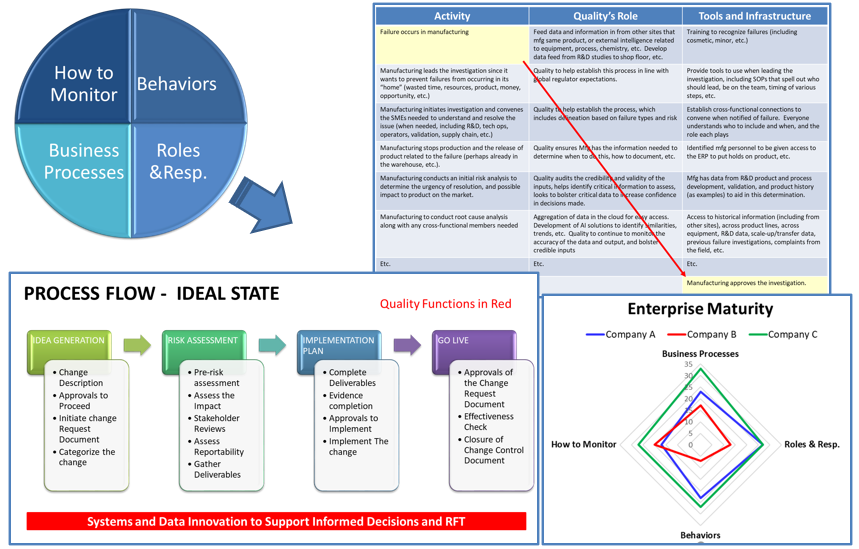Adaptability and Agility Maturity Model
The Chief Quality Officer Forum is passionate about advancing the Culture of Quality (product, process and systems quality) to optimize patient and business success. The team first assessed the Role of the Quality Department across the organization to determine how best to enable desired outcomes, then developed a maturity model by which organizations can assess areas of strengths and opportunities. Additionally, the CQO Forum referenced the work conducted by Xavier University and industry members to identify how to measure culture.
Take the time to understand how you can advance the Culture of Quality in your organization!
Phase 2 Launched!
Pathway has launched Phase 2 of the Adaptability and Agility Maturity Work, which has folded-in the Phase 1 work, FDA maturity models (CDER, CDRH/MDIC, Digital Pre-Cert), and industry models (BPOG Digital Plant Maturity, AQPC Knowledge Management Maturity, AFDO/RAPS AI Maturity, etc.).
Our Team:
Robin Blankenbaker, Siemens
Laura Caldwell, CSL Behring
Adam Caruso, Merck
Russell Ciliento, CSL Behring
Brian Dunstan, Glaukos
Amanda Garner, Illumina
Niraj Mehta, Merck
Rosane Olyha, Elanco
Marla Phillips, Pathway
Michael Polansky, AstraZeneca
Questions, or want to join the team? Contact Marla Phillips
Phase 1: A Glimpse of our Work
The cultural work presented on this page is provided to help inform your cultural journey. The work is not complete yet, but perhaps some of the outcomes will be beneficial to you.
The Role of the Quality Department
Xavier University graduate students conducted a study to identify what the Quality Department should “Stop” doing, “Start” doing, and “Continue” doing. The themes identified, matched with the Metrics that Matter work, can inform how your organization can align objectives, metrics and work processes. Your employees know the barriers that prevent your organization from advancing, so take the time to understand and remove these barriers…today.
How to Measure Culture
Xavier University and PwC, in partnership with Schelling Point, asked a team of cultural experts “What do you need to see in action to know a company has a strong culture of quality”. Since the responses can be seen in action, then companies can measure to what degree the actions are present. Your employees know what is working and what is not, and this contrasts with the view senior leaders have of their operations. Read the Xavier/PwC Cultural Report to learn how you can start measuring the strength of your company’s culture.
Cultural Maturity Model
The Chief Quality Officer team chartered a team of their employees to develop a Cultural Maturity Model based on the findings from the “Role of Quality” and “Metrics that Matter” work. The draft model includes development across the following swim lanes (not available for download until the work is complete):
Roles and Responsibilities of Quality. Moving from contentious police-mentality between Quality and the rest of the organization, to enterprise-wide ownership of the “why” behind the regulatory intelligence needed to scientifically support the safety and efficacy of all products.
Business Processes. Moving from GMPs as a requirement to systems innovation driving a predictive culture focused on right first time, while linked to external regulatory intelligence.
Behaviors. Moving from Quality Leaders having limited visibility to Quality System issues, to increasing levels of collaborative ownership, to enterprise-wide focus on effectiveness at the earliest stages possible.
How to Monitor. Moving from reactive, to proactive, to predictive, to prescriptive.
Questions? Please contact Marla Phillips at Marla.Phillips@Pathway4PH.org, or use the Contact Us form. Thank you for your interest!


